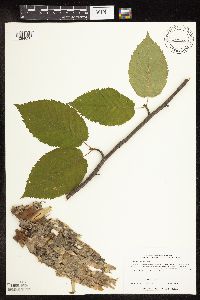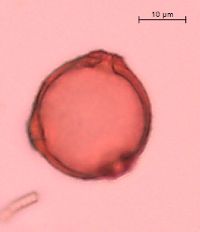Betula alleghaniensis
|
|
|
|
Family: Betulaceae
Yellow Birch
|
Trees , to 30 m; trunks straight, crowns narrowly round. Bark of young trunks and branches dark reddish brown, in maturity tan, yellowish, or grayish, lustrous, smooth, irregularly exfoliating, or sometimes darkening and remaining close; lenticels dark, horizontally expanded. Twigs with odor and taste of wintergreen when crushed, glabrous to sparsely pubescent, usually covered with small resinous glands. Leaf blade narrowly ovate to ovate-oblong with (9--)12--18 pairs of lateral veins, 6--10 × 3--5.5 cm, base rounded to cuneate or cordate, margins sharply doubly serrate, teeth coarse, rather irregular, apex acuminate; surfaces abaxially usually moderately pubescent, especially along major veins and in vein axils, often with scattered, minute, resinous glands. Infructescences erect, ovoid, 1.5--3 × 1--2.5 cm, generally remaining intact after release of fruits in late fall; scales sparsely to moderately pubescent, lobes diverging proximal to middle, central lobe tapering to narrow tip, lateral lobes ascending or partially extended, broader, rounded. Samaras with wings narrower than body, broadest near summit, not or only slightly extended beyond body apically. 2 n = 84. Flowering late spring. Stream banks, swampy woods, and rich, moist, forested slopes; 0--500 m; St. Pierre and Miquelon; N.B., Nfld., N.S., Ont., P.E.I., Que.; Ala., Conn., Ga., Ill., Ind., Iowa, Ky., Maine, Md., Mass., Mich., Minn., N.H., N.J., N.Y., N.C., Ohio, Pa., R.I., S.C., Tenn., Vt., Va., W.Va., Wis. Betula alleghaniensis is a characteristic tree of the northern Appalachians and the hemlock hardwoods forest of the Great Lakes region. It was formerly widely known by the illegitimate (superfluous) name B . lutea F. Michaux. Tree 18 - 30 m tall, trunk 0.60 - 1 m in diameter Leaves: alternate, short-stalked, solitary on long shoots, in pairs on spur shoots, dull dark green above, yellowish green beneath, 7 - 12 cm long, 3 - 6 cm wide, oval with a rounded to wedge- or heart-shaped base and a pointed tip, sharply toothed, early leaves turning smooth, late leaves remaining hairy, typically with eight to twelve pairs of veins. Flowers: either male or female, found on the same tree (monoecious), borne in catkins. Male catkins are purplish yellow, 7 - 10 cm long, and hanging. Female catkins green, 2 cm long, erect, with three-lobed scales that are hairy along the back and edges. Fruit: narrow-winged (samara), borne in erect oval catkins 2 - 4 cm long that persist into winter. The samaras are oval to egg-shaped with a hairy tip. Bark: dark reddish brown, thin and smooth, becoming shiny yellowish gray with corky horizontal lines (lenticels), often exfoliating in horizontal strips with curled edges. Twigs: thin, greenish and hairy, becoming smooth, shiny, and silvery gray to light orange. A wintergreen scent is realeased when twigs are scratched. Short spur shoots develop on older growth. Terminal buds: absent. Form: open and rounded with thin, hanging branches and a straight trunk. End and lateral buds: brown, 5 - 7 mm long, conical with a short pointed tip, scales somewhat hairy. Similar species: Betula alleghaniensis is easy to distinguish from other birches of the Chicago Region because it has peeling yellowish gray bark, leaves with around eight to twelve pairs of lateral veins, and the twigs smell like wintergreen when scratched. It hybridizes with Betula pumila (Betula x purpusii), but the hybrid is more shrub-like and has characteristics intermediate of the two parents. Flowering: mid April to late May Habitat and ecology: Local in boggy woods. This species is most commonly found in Berrien County. Occurence in the Chicago region: native Notes: The wood of this species is used to make furniture, cabinets, veneer, flooring, boxes, plywood, paneling, doors, and interior trim. The seedlings sometimes germinate on rotting stumps or logs that later decay, leaving the tree to balance on stilt-like roots. Etymology: Betula is the Latin name for birch. Alleghaniensis refers to the Allegheny Mountains of the Eastern United States. Author: The Morton Arboretum Tree to 30 m, the lustrous, yellowish-gray bark exfoliating in thin plates, appearing finely shaggy, eventually becoming dark and roughened in large trees; crushed twigs with the flavor of wintergreen; lvs lance-ovate to ovate, ovate-oblong or somewhat obovate, 6-10 cm, short- acuminate, coarsely and sharply toothed, rounded or subcordate at base, at maturity softly pubescent on the veins beneath, especially in the vein-axils, often paired on short spur-branches; lateral veins mostly 9-12 pairs; fruiting catkins sessile or nearly so, ovoid to short-cylindric, 2-3 cm; scales 6-13 mm, pubescent and ciliate, with ascending or divergent, oblong lobes; frs 2.5-4.5 mm, round-obovoid to subrotund or oblate, the body 1.5-2.5 mm wide, more than half as wide as the whole fr; 2n=84. Moist, chiefly seral woods; Nf. to se. Man., s. to Del., Pa., O., n. Ind., Wis., Minn., and occasionally Io., and along the mts. to n. Ga. (B. lutea) Gleason, Henry A. & Cronquist, Arthur J. 1991. Manual of vascular plants of northeastern United States and adjacent Canada. lxxv + 910 pp. ©The New York Botanical Garden. All rights reserved. Used by permission. From Flora of Indiana (1940) by Charles C. Deam After a careful study of my specimens, I believe they all belong to the variety [var. macrolepis] rather than to the species. Fernald (Rhodora 24: 170. 1922) refers to two specimens of the species from Indiana. [Deam's var. macrolepis (with longer scales (8-13 mm) in the fruiting catkins)] is found locally in the northern part of the state and on the sides of two deep, rocky ravines about a mile east of Taswell in Crawford County. In northern Indiana it apparently is one of the chief species in the succession after tamarack and is associated with white elm, red maple, black ash, and silver maple. All of my northern specimens have a dark bark and I believe they all belong to the dark bark form recently described by Fassett (Rhodora 34: 95. 1932) as Betula lutea Michx. f. forma fallax Fassett. ...... Indiana Coefficient of Conservatism: C = 10 Wetland Indicator Status: FAC |
|
|
|





































































